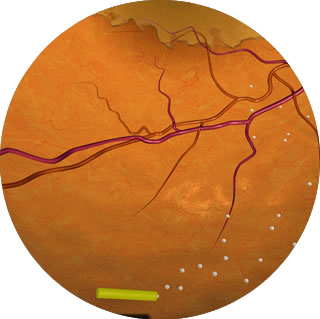Steroid Therapy
Numerous retinal conditions cause a significant amount of inflammation in the retina. This can worsen the problem of damaged blood vessels and encourage further leakage of fluid. Steroids are a recommended treatment method as they are anti-inflammatory and contribute to controlling these blood vessels and reducing swelling (macular oedema).

What is steroid therapy used for?
The main retinal conditions that use steroid therapy as a treatment method are; Diabetic Macular Oedema and Retinal Vein Occlusion. Although different conditions and symptoms, they both cause inflammation to the retina.
Diabetic Macular Oedema occurs when consistent high blood sugar (as a result of diabetes) causes damage to the blood vessels in the macular of the eye. This can then lead to fluid leaking into the retina, therefore affecting vision.
Retinal Vein Occlusion also causes inflammation but in a different way. A blockage occurs in the retinal vein due to a build-up of pressure which causes swelling and loss of vision.
There are two types of steroid therapy; Ozurdex and Iluvien.

What is the difference between Ozurdex and Iluvien?
Ozurdex and Iluvien are very similar types of steroid therapy, however, there are slight differences.
Ozurdex is a steroid implant that is injected into the vitreous jelly in the back of the eye, slowly dissolving and releasing the medication over time, lasting up to 6 months.
It is most commonly used to treat macular oedema caused by Central or Branch Retinal Vein Occlusion and works to reduce inflammation in the retina. Similarly, Iluvien is also a steroid implant that is injected into the vitreous jelly of the eye. The difference is that this type of treatment is better suited to those with Diabetic Macular Oedema at a stage where the condition has not responded to any other forms of therapy. Iluvien lasts significantly longer than Ozurdex, for up to 3 years.
The process:
- Administered as an outpatient procedure, patients are positioned comfortably for the eye to be numbed with anaesthetic eye drops.
- The skin around the eye is cleaned, a sterile drape is then placed around the eye and a small clip (known as a speculum) is used to prop the eyelids open.
- The steroid implant is injected into the eye with little to no pain experienced.
- Antibiotic drops are applied which the patient needs to continue as after care in the days following.
- With a short procedure and recovery time, patients are generally free to return to normal activities immediately.
Different applicators are used for Ozurdex and Iluvien, but apart from this, the procedure is the same.
Should I be worried about any potential risks?
With any procedure, minor or major, there are always potential risks that the patient should be aware of.
Two common side effects of Ozurdex include;
- Raised eye pressure – this needs to be monitored and can be controlled with topical anti-pressure drops, however, patients may require surgery to reduce the pressure if it does not subside.
- Cataract formation – if a cataract does form, the patient may need surgery to remove it and restore their vision.
Rare but more serious complications include;
- Serious infection in the eye
- Detached retina
- Bleeding
- Inflammation
Iluvien also carries a risk of raised eye pressure, with regular monitoring necessary.
Get in touch
Highly trained Consultant Ophthalmic Surgeon, Mr Venki Sundaram carries out steroid therapy in clinics across Hertfordshire. Get in touch today to make an appointment.

